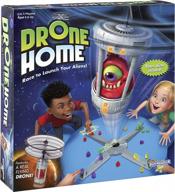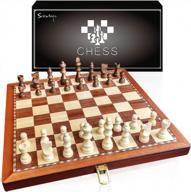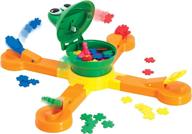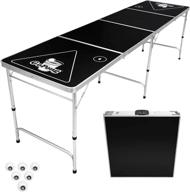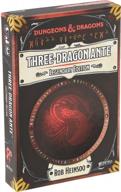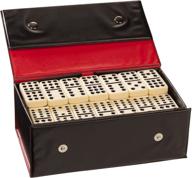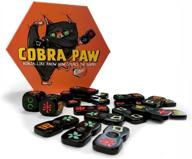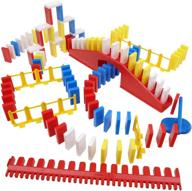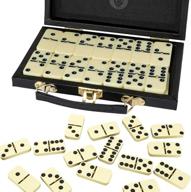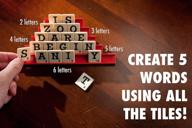Similar products
The Ever-Popular World of Tile Games
For generations, tile-based games have been a staple in households across the world. These classic games are not just for rainy days or family game nights - they offer meaningful interaction and engagement for players of all ages. Let's explore what makes these tile games so universally appealing.
A History of Tile Games
Tile games trace their history back thousands of years. Dominoes emerged in China as early as the 12th century, while Mahjong developed in the 19th century. Rummikub was invented by Ephraim Hertzano in the 1930s. Popular word games like Scrabble and Boggle arrived in the 1930s-1950s. The simplicity of tiles paired with numbers or letters allowed for endless gameplay variations over the years.
Popular Tile Games Today
Many classic tile games remain popular in households today. Here are some of the most recognizable titles:
- Scrabble - Players create words from letter tiles to score points
- Bananagrams - Fast-paced word game, like Scrabble without a board
- Rummikub - Combine numbered tiles into sets and runs
- Mahjong - Matching and removal of decorative Chinese tiles
- Boggle - Find words in a grid of random letters
- Dominoes - Create chains off matching ends of domino tiles
The Appeal of Tile Games
What is it that makes tile games so universally fun and lasting? Here are some of their key advantages:
- Portability - The compact tiles are easy to transport and play anywhere.
- Quick to learn - Simple gameplay accessible for children and adults.
- Skill development - Promotes strategy, math, spelling, vocabulary, and more.
- Social experience - Brings people together around a shared activity.
- Replay value - Random or changing tile configurations keep it fresh.
- Inexpensive - Games are affordable and great value.
Tile games offer entertainment and enrichment for all. Their continued popularity is a testament to their versatility and enduring fun factor. Give one of these classic titles a try for an engaging analog experience.
Another interesting products
A Guide to Popular Tile Games
Tile-based games come in many shapes and sizes, each offering their own unique gameplay. Here's an overview of some of the most popular tile games and their key characteristics.
Scrabble
In Scrabble, players draw letter tiles and take turns creating words on the gameboard to score points. The goal is to use strategy to form high-value words. For example, placing common letters like 'E' on triple word or letter score boxes nets more points. Scrabble builds vocabulary as players reference dictionaries to find legitimate words to play.
Bananagrams
Bananagrams is like a fast-paced version of Scrabble without a board. Players race against each other to form intersecting crossword-style words using all their tiles. They can rearrange their words as new letters are drawn. Bananagrams is great for developing quick thinking and pattern recognition. Setting a timer adds excitement and challenge to the gameplay.
Rummikub
In Rummikub, players use numbered and colored tiles to form sets and runs on the table. For example, a run could be the sequence of tiles: blue 5, red 6, black 7. The first to play all their tiles wins. Rummikub combines elements of gin rummy and mahjong. It helps promote logical thinking, planning, and math skills.
Mahjong
The goal of Mahjong is to match and remove decorative Chinese tiles from the stack. The Mahjong set contains tiles with matching suits and designs, like bamboo sticks, Chinese characters, and dots. Matching pairs of tiles are removed until none are left. Mahjong builds visual pattern recognition, memory, and strategy skills.
Dominoes
Players draw dominoes with numbers on each end and create branching chains off matching ends. For example, a tile with 5-6 can connect to one with 6-3. The first player to play all their dominoes wins. Dominoes teaches logic, planning ahead, and computational thinking as players strategize to outmaneuver their opponents.
Boggle
In Boggle, players search for words hidden in a grid of random letters. The goal is to find as many words as possible within the time limit. Boggle boosts pattern recognition, thinking flexibly, and vocabulary as players connect letters in new ways. Allowing dictionary use removes guessing and enables advanced play.
Word Search
Word search puzzles hide words vertically, horizontally, and diagonally within a letter grid. Players locate and circle the hidden words. Besides vocabulary building, word searches improve concentration, observation, and attention to detail. Word search books provide portable entertainment for all ages.
With endless variations, tile games offer something for everyone. Try out these popular titles for engaging analog fun that stimulates the mind.
Why Tile Games are Good for Your Brain and Social Life
Beyond just being fun, classic tile games offer many benefits that make them worth playing. From cognitive development to social interaction, tile games have a lot to offer players of all ages.
Cognitive Development
Tile games engage your brain in many ways:
- Strategy - Planning moves and outthinking opponents exercises logic and reasoning skills.
- Vocabulary - Word games like Scrabble and Boggle build language skills and vocabulary.
- Math - Tile-based math games reinforce arithmetic, numbers and patterns.
- Memory - Remembering tile locations/matches exercises short term memory.
- Concentration - Focusing on finding words/matches improves concentration.
Vocabulary Building
Word tile games naturally reinforce vocabulary. Scrabble requires forming real words to score. Players often keep dictionaries on hand. Boggle challenges you to form words from random letters. Both games motivate learning new word meanings and spelling.
Social Interaction
Tile games are engines of social interaction. Features like:
- Multiplayer format
- Face-to-face play
- Conversation while playing
- A shared goal
Bring people together and stimulate social connection. This makes tile games ideal for family game nights or parties.
Entertainment for All Ages
Easy to learn tile games accommodate every generation playing together. Kids can start playing at a young age. Adults enjoy tile games their whole lives. Matching gameplay difficulty to players' skills keeps the challenge fun for everyone.
Portable and Inexpensive
You can take tile games anywhere and they provide great entertainment value. Tiles easily fit in bags and boxes, ready for travel and play on-the-go. Many classic titles are also very affordable, especially compared to expensive video game systems and games.
With benefits like these, tile games deserve a place in every home.
How to Select the Right Tile Game
With so many tile games to choose from, it can be tricky to pick the right one. Factors like age range, number of players, and gameplay style help determine which title is the best fit.
Consider Age Range
Tile games work for a wide span of ages, but some are better suited for certain groups:
- Preschoolers - Matching and memory games, simple dominoes.
- Elementary age - Junior versions of Scrabble, Boggle, word searches.
- Teens & adults - Bananagrams, standard Scrabble, Mahjong, Rummikub.
- Seniors - Large piece dominoes, Mahjong, familiar classics.
Number of Players
Some key tile games for different numbers:
- Solo - Solitaire card games, word searches, crosswords, sudoku.
- 2 players - Scrabble, Chess, Checkers, Bananagrams.
- 3-4 players - Rummikub, Boggle, Dominoes, Triominoes.
- 5+ players - Mahjong, Quiddler, traditional dominoes.
Skill Level
Tile games range from casual fun to intense brain burners:
- Beginner - Matching, Checkers, Junior versions.
- Intermediate - Traditional versions, Dominoes, Boggle.
- Advanced - Scrabble, Chess, high-level Mahjong.
Game Duration
Look at estimated game length:
- Quick - 15-30 mins: Bananagrams, Rummy tiles.
- Medium - 30-60 mins: Rummikub, Boggle, Dominoes.
- Long - 60+ mins: Scrabble, Mahjong.
Genre Preferences
Select by gameplay type:
- Word - Scrabble, Boggle, Bananagrams.
- Math - Rummikub, Dominoes, Mahjong.
- Strategy - Chess, Checkers, Triominoes.
- Memory - Matching games, Mahjong.
Choosing the right tile game provides an experience everyone can enjoy.
Top Tips for Mastering Tile Games
Tile games offer great entertainment, but you can maximize the experience with the right learning and gameplay strategies. Here are some tips to help you get the most out of these classic board games.
Build Your Vocabulary
For word tile games like Scrabble and Bananagrams, building your vocabulary is key:
- Study word lists and spelling guides
- Read dictionaries and highlight new words to memorize
- Practice anagrams and other word puzzles
- Play online word games to increase exposure
Learn Game Variations
Most tile games have multiple gameplay variations to add diversity:
- Scrabble - Speed Scrabble, Scrabble variants like Upwords
- Rummikub - Rummikub spinners, tiles games like Tri-Ominos
- Dominoes - Draw dominoes, block dominoes
Use Timers for Fast-Paced Play
Adding timers increases excitement and challenge:
- Bananagrams - Use a 3-minute sand timer for fast pace
- Boggle - Timers create a sense of urgency
- Rummy tiles - Limit time for forming sets
Try Game Apps and Online Versions
Mobile apps and online tile games provide extra opportunities for practice:
- Scrabble Go app for on-the-go play
- Online Boggle and Sudoku for solo practice
- Mahjong solitaire and classic puzzles
Use Helpful Accessories
Accessories enhance the experience:
- Scrabble - Scrabble word finders, deluxe rotating boards
- Boggle - Boggle letter cubes, sand timers
- Dominoes - Dominoes game boxes, scoreboards
Learn Game Strategy Basics
Understanding game strategy gives you an edge. Study:
- Scrabble - High value spaces, letter scoring
- Mahjong - Tile matching and chains
- Dominoes - Understanding suits, blocking
Mastering these tips will make you a tile game pro in no time!
Top products in 🧩 Tile Games
The Most Popular Tile Games
Tile games have entertained families for generations. Here are some of the most recognizable and enduring titles:
Scrabble
Players draw letter tiles and take turns creating intersecting words on the gameboard to score points. Scrabble combines skill with an element of luck as players draw different letters. It builds vocabulary as players reference dictionaries for word legitimacy.
Bananagrams
In this fast-paced word game, players race to build crossword grids using all their tiles first. New letters are drawn from the central pool, so game adaptability is key. Bananagrams is like speed Scrabble without a board.
Rummikub
With numbered and colored tiles, players form and manipulate sets and runs on the table. Be the first to play all your tiles to win. Rummikub combines rummy and mahjong elements in a game of logic and strategy.
Mahjong
This tile-based game uses engraved Chinese symbols and bright designs. The object is to match identical tiles and remove them from the stack until none remain. Mahjong improves visual memory, concentration, and pattern recognition.
Boggle
Players shake letter cubes in a grid to form random words in any direction. The goal is to create as many words as possible within the time limit. Boggle boosts pattern recognition and vocabulary.
Dominoes
Players draw domino tiles with numbers on each end to form chain reactions off matching ends. Traditional double-six dominoes include 28 tiles with dots from 0 to 6. Dominoes teaches strategy and planning ahead.
These enduring tile game classics have stood the test of time thanks to their engaging yet accessible gameplay.
Tile Game Gift Guide
Tile games make great gifts for game nights, travel, and more. Here are some top tile game recommendations for different gift recipients:
Kids
- Bananagrams - Fast-paced wordplay.
- Blokus - Colorful strategy game.
- Zingo! - Bingo with picture tiles.
- Colour Brain - Match colors and shapes.
Teens
- Scrabble - Vocabulary builder.
- Rummikub - Numbers game.
- Settlers of Catan - Strategy and trading.
- Quirkle - Abstract shape/color combos.
Adults
- Scrabble Deluxe - Rotating board, storage.
- Mahjong - Matching puzzle game.
- Bananagrams - Portable fun.
- Boggle - Word search cubes.
Seniors
- Large piece dominoes - Easy to handle.
- Large piece Mahjong - Vintage tile game.
- Rummikub Large Print - Numbered tiles game.
- Big Boggle - Oversized letter cubes.
Travelers
- Magnetic Bananagrams - No loose tiles.
- Collapsible Scrabble - Folding board.
- Compact Chess - Magnetic set.
- Waterproof Playing Cards - Durable cards.
Tile games make memorable gifts for all ages. Give the gift of entertainment and interaction.
How Amazon Prime Boosts Your Tile Game Purchases
For enthusiasts who regularly buy tile games, an Amazon Prime membership can make the purchasing experience even smoother. Let's look at some of the key Prime benefits for tile game buyers.
Free Two-Day Shipping
Prime members enjoy free two-day shipping on millions of Prime-eligible items. This means quick delivery for those impulse tile game purchases and no minimum order size for free shipping. You can get that hot new word game or the replacement Boggle letter cube delivered super fast.
Prime Day Deals
Amazon Prime Day is an annual event with exclusive members-only deals across all categories. Keep an eye out for deep discounts on tile games and accessories during Prime Day and get your collection upgraded on the cheap.
Free Release-Date Delivery
For tile gamers who love pre-ordering the latest editions, Prime offers free release-date delivery so your brand new tile game arrives on launch day. No more waiting or paying extra for on-time delivery.
Prime Video Game Streaming
When you need a break from tabletop play, Prime Video offers free streaming of shows, movies and more to entertain tile game fans. Catch chess documentaries, e-sports, and more game-related content.
With these Prime perks tailored for tile game buyers, an Amazon Prime subscription quickly pays for itself. Sign up today to upgrade your tile game purchasing experience.
What Are The Most Popular Tile Games In The Market??
Based on the search results, here are some of the most popular tile games in the market:
Note that this is not an exhaustive list and there may be other popular tile games in the market.
What Are The Differences Between Tile-Placement Board Games And Other Types Of Board Games??
Tile-placement board games are a type of board game that involves placing tiles on a board to create a pattern, build a structure, or score points. Here are some differences between tile-placement board games and other types of board games:
Overall, tile-placement board games offer a unique and satisfying gameplay experience that is different from other types of board games.








